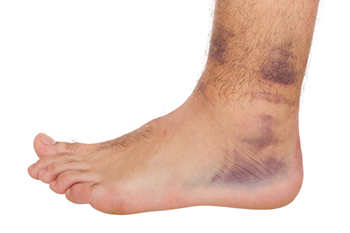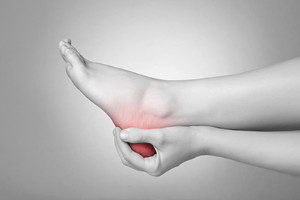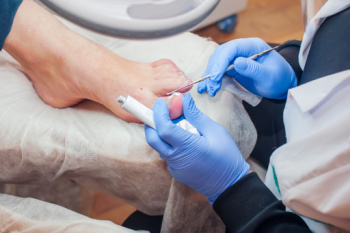Connect With Us
Blog
Items filtered by date: July 2025
Causes and Grades of Ankle Sprains

Ankle sprains are common injuries caused by sudden twisting or rolling of the ankle, often during sports or uneven walking. Inversion sprains affect the outer ligaments of the ankle, while eversion sprains impact the inner ones. Sprains are categorized into three grades. A mild sprain, or Grade 1, causes slight swelling and discomfort. A moderate sprain, or Grade 2, results in partial tearing with pain, bruising, and difficulty walking. A severe sprain, or Grade 3, involves complete tearing of ligaments, significant swelling, and ankle instability. A podiatrist can diagnose the severity, provide targeted treatment, and recommend therapies to restore strength and mobility. If you have sustained an ankle sprain, it is recommended that you schedule an emergency visit with a podiatrist today for a comprehensive evaluation and expert care.
Ankle sprains are common but need immediate attention. If you need your feet checked, contact Jeffrey Radack, DPM from Texas Regional Foot & Ankle Clinics. Our doctor can provide the care you need to keep you pain-free and on your feet.
How Does an Ankle Sprain Occur?
Ankle sprains take place when the ligaments in your ankle are torn or stretched beyond their limits. There are multiple ways that the ankle can become injured, including twisting or rolling over onto your ankle, putting undue stress on it, or causing trauma to the ankle itself.
What Are the Symptoms?
- Mild to moderate bruising
- Limited mobility
- Swelling
- Discoloration of the skin (depending on severity)
Preventing a Sprain
- Wearing appropriate shoes for the occasion
- Stretching before exercises and sports
- Knowing your limits
Treatment of a Sprain
Treatment of a sprain depends on the severity. Many times, people are told to rest and remain off their feet completely, while others are given an air cast. If the sprain is very severe, surgery may be required.
If you have suffered an ankle sprain previously, you may want to consider additional support such as a brace and regular exercises to strengthen the ankle.
If you have any questions please feel free to contact our office located in McKinney and Coppell, TX . We offer the newest diagnostic and treatment technologies for all your foot and ankle needs.
Are You Suffering From Ingrown Toenails?
How Walking and Running Shoes Differ

Walking and running shoes may appear similar, but they are designed to meet different demands placed on the feet. Walking places less impact on the foot, with the heel striking first followed by a rolling motion through the step. As a result, walking shoes are often built with softer soles and an angled heel to cushion impact and promote a smooth transition. Running, however, places greater force on the feet, often up to three times the body weight, and may involve striking with the heel, midfoot, or forefoot. To handle this stress, running shoes are typically lighter and built with thicker cushioning to absorb shock and reduce fatigue. Choosing the wrong shoe can lead to foot pain or injury, including plantar fasciitis or Achilles tendon pain. A podiatrist can assess your gait, foot structure, and any symptoms you may be experiencing. It is suggested that you schedule an appointment with this type of doctor to determine the cause of the pain and receive guidance on proper footwear.
For more information about walking shoes versus running shoes, consult with Jeffrey Radack, DPM from Texas Regional Foot & Ankle Clinics. Our doctor can measure your feet to determine what your needs are and help you find an appropriate pair of footwear.
Foot Health: The Differences between Walking & Running Shoes
There are great ways to stay in shape: running and walking are two great exercises to a healthy lifestyle. It is important to know that running shoes and walking shoes are not interchangeable. There is a key difference on how the feet hit the ground when someone is running or walking. This is why one should be aware that a shoe is designed differently for each activity.
You may be asking yourself what the real differences are between walking and running shoes and the answers may shock you.
Differences
Walking doesn’t involve as much stress or impact on the feet as running does. However, this doesn’t mean that you should be any less prepared. When you’re walking, you land on your heels and have your foot roll forward. This rolling motion requires additional support to the feet.
Flexibility – Walking shoes are designed to have soft, flexible soles. This allows the walker to push off easily with each step.
If you have any questions, please feel free to contact our office located in McKinney and Coppell, TX . We offer the newest diagnostic and treatment technologies for all your foot care needs.
Retrocalcaneal Bursitis

Retrocalcaneal bursitis, also known as heel bursitis, is the inflammation of the fluid-filled sac located between the Achilles tendon and the heel bone. This condition often develops from repetitive stress, overtraining, or wearing poor footwear that places excessive pressure on the back of the heel. Symptoms typically include swelling, redness, and pain when walking or wearing certain shoes. A podiatrist can provide relief through proper diagnosis, custom orthotics, and treatments that reduce inflammation and prevent recurrence. Addressing the root cause is essential for healing and comfort. If you are experiencing persistent heel pain, do not wait. Please promptly schedule an appointment with a podiatrist who can offer appropriate treatment and relief solutions for heel bursitis.
Foot Pain
Foot pain can be extremely painful and debilitating. If you have a foot pain, consult with Jeffrey Radack, DPM from Texas Regional Foot & Ankle Clinics. Our doctor will assess your condition and provide you with quality foot and ankle treatment.
Causes
Foot pain is a very broad condition that could be caused by one or more ailments. The most common include:
- Bunions
- Hammertoes
- Plantar Fasciitis
- Bone Spurs
- Corns
- Tarsal Tunnel Syndrome
- Ingrown Toenails
- Arthritis (such as Gout, Rheumatoid, and Osteoarthritis)
- Flat Feet
- Injury (from stress fractures, broken toe, foot, ankle, Achilles tendon ruptures, and sprains)
- And more
Diagnosis
To figure out the cause of foot pain, podiatrists utilize several different methods. This can range from simple visual inspections and sensation tests to X-rays and MRI scans. Prior medical history, family medical history, and any recent physical traumatic events will all be taken into consideration for a proper diagnosis.
Treatment
Treatment depends upon the cause of the foot pain. Whether it is resting, staying off the foot, or having surgery; podiatrists have a number of treatment options available for foot pain.
If you have any questions, please feel free to contact our office located in McKinney and Coppell, TX . We offer the newest diagnostic and treatment technologies for all your foot care needs.
Recognizing the Stages of Toenail Fungus

Toenail fungus progresses through early, moderate, and advanced stages. In the early stage, the nail may develop white or yellow spots and mild discoloration. The moderate stage brings thickening, increased discoloration, and brittleness. In the advanced stage, the nail may become deformed, separate from the nail bed, and emit an odor. Risk factors include walking barefoot in damp areas, wearing tight shoes, or having diabetes or poor circulation. Symptoms worsen over time and can cause pain or difficulty walking. A podiatrist can diagnose the severity of the infection and provide treatment, such as debridement, antifungal therapy, or laser treatment. If you have symptoms of toenail fungus, it is strongly suggested that you consult a podiatrist who can offer effective treatment solutions, which may include prescribed medication.
If left untreated, toenail fungus may spread to other toenails, skin, or even fingernails. If you suspect you have toenail fungus it is important to seek treatment right away. For more information about treatment, contact Jeffrey Radack, DPM of Texas Regional Foot & Ankle Clinics. Our doctor can provide the care you need to keep you pain-free and on your feet.
Symptoms
- Warped or oddly shaped nails
- Yellowish nails
- Loose/separated nail
- Buildup of bits and pieces of nail fragments under the nail
- Brittle, broken, thickened nail
Treatment
If self-care strategies and over-the-counter medications does not help your fungus, your podiatrist may give you a prescription drug instead. Even if you find relief from your toenail fungus symptoms, you may experience a repeat infection in the future.
Prevention
In order to prevent getting toenail fungus in the future, you should always make sure to wash your feet with soap and water. After washing, it is important to dry your feet thoroughly especially in between the toes. When trimming your toenails, be sure to trim straight across instead of in a rounded shape. It is crucial not to cover up discolored nails with nail polish because that will prevent your nail from being able to “breathe”.
In some cases, surgical procedure may be needed to remove the toenail fungus. Consult with your podiatrist about the best treatment options for your case of toenail fungus.
If you have any questions, please feel free to contact our office located in McKinney and Coppell, TX . We offer the newest diagnostic and treatment technologies for all your foot care needs.
Exploring Negative Pressure Wound Care

Negative pressure wound therapy applies controlled suction to non‑healing wounds on the foot, toes, or ankle to reduce excess fluid, improve blood flow, and stimulate healthy tissue formation. A podiatrist evaluates the wound’s depth, tissue condition, and surrounding skin before implementing therapy. The procedure involves using a porous dressing connected to a device that gently draws out excess fluids and encourages the wound edges to contract. This type of wound care also supports new tissue growth and promotes circulation. By removing excess fluid and proteins, the therapy helps restore proper pressure balance in the wound bed. It is most suitable for ulcers, non‑healing surgical sites, or complicated ankle wounds that have stalled in healing. Negative pressure therapy supports wound closure while it also minimizes infection risk and avoids unnecessary surgery. If you have foot wounds that will not heal, it is suggested that you schedule an appointment with a podiatrist for appropriate treatment.
Wound care is an important part in dealing with diabetes. If you have diabetes and a foot wound or would like more information about wound care for diabetics, consult with Jeffrey Radack, DPM from Texas Regional Foot & Ankle Clinics. Our doctor will assess your condition and provide you with quality foot and ankle treatment.
What Is Wound Care?
Wound care is the practice of taking proper care of a wound. This can range from the smallest to the largest of wounds. While everyone can benefit from proper wound care, it is much more important for diabetics. Diabetics often suffer from poor blood circulation which causes wounds to heal much slower than they would in a non-diabetic.
What Is the Importance of Wound Care?
While it may not seem apparent with small ulcers on the foot, for diabetics, any size ulcer can become infected. Diabetics often also suffer from neuropathy, or nerve loss. This means they might not even feel when they have an ulcer on their foot. If the wound becomes severely infected, amputation may be necessary. Therefore, it is of the upmost importance to properly care for any and all foot wounds.
How to Care for Wounds
The best way to care for foot wounds is to prevent them. For diabetics, this means daily inspections of the feet for any signs of abnormalities or ulcers. It is also recommended to see a podiatrist several times a year for a foot inspection. If you do have an ulcer, run the wound under water to clear dirt from the wound; then apply antibiotic ointment to the wound and cover with a bandage. Bandages should be changed daily and keeping pressure off the wound is smart. It is advised to see a podiatrist, who can keep an eye on it.
If you have any questions, please feel free to contact our office located in McKinney and Coppell, TX . We offer the newest diagnostic and treatment technologies for all your foot care needs.

